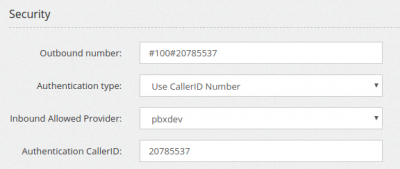Custom Extensions: Difference between revisions
No edit summary |
No edit summary |
||
| Line 8: | Line 8: | ||
[[file:securitycustomextension.png|400px]] | [[file:securitycustomextension.png|400px]] | ||
The CallerID must match exactly | |||
== Outbound calls == | |||
When you need to call the extension, you can specify the number to dial. That number will be routed accordingly to the routing profile assigned to the extension or the tenant. You may need to specify a special code, like in this case, #100#, to select the Mobile phone trunk | |||
Latest revision as of 16:19, 13 May 2018
A custom extension can be used for a large series of special configurations. It was developed with Mobile Twinning in mind. In some countries you can ask a mobile phone operator to be directly interconnected to the mobile network, usually using a normal SIP trunk. In this way, when a mobile phone makes a call, you'll receive the INVITE from that trunk, as it was a normal SIP phone. When you want to ring a mobile phone, you can send the call to the mobile phone number using that special trunk. In some other countries this is named "Virtual Mobile Operator".
The custom extension can also be used for interconnecting a remote PBX and maybe have some phones directly connected to the remote PBX and some other connected to the MiRTA PBX.
Inbound calls
Inbound calls from a SIP Provider can be assigned to the custom extension (like they were dialed from a SIP phone using that extension) by setting the provider as "Allow custom extensions" and then specifying the CallerID for the incoming call as the authentication mechanism. It is important you trust the callerID for the incoming calls from the special SIP Provider.
The CallerID must match exactly
Outbound calls
When you need to call the extension, you can specify the number to dial. That number will be routed accordingly to the routing profile assigned to the extension or the tenant. You may need to specify a special code, like in this case, #100#, to select the Mobile phone trunk
